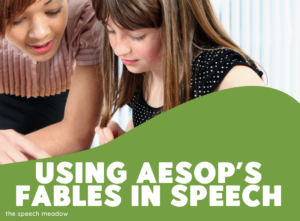As school Speech Language Pathologists, we’re always looking for engaging and effective ways to help our students improve their language skills. One timeless resource that is effective is using Aesop’s fables. These classic tales, dating back to ancient Greece, offer more than just moral lessons. They provide rich language and storytelling that can be incredibly beneficial for learners. Let’s explore using Aesop’s fables in speech therapy.

Easily Adaptable to a wide range of ages and developmental levels
Aesop’s fables can be easily adapted to a wide range of ages and language levels. You can easily adapt these stories with children as young as kindergarten through to high school. The discussion of age appropriate materials typically doesn’t happen as it sometimes does with fairy tales.
Tier Two Vocabulary
Aesop’s fables are filled with descriptive language that can enrich a child’s vocabulary. From words like cunning, mischief to loyalty and compassion, these stories introduce students to a range of tier two words. By discussing these words in the context of the story, we can help students understand their meanings then use them appropriately in their own speech and writing.
On top of this, many common idioms come from Aesop’s fables, particularly in other literature. Using Aesop’s fables allows your students to expand their understanding of different idioms. For example, “Don’t count your chickens before they hatch.”
Story Grammar
Aesop’s fables offer a perfect platform for practicing story grammar skills. As we read these stories with our students, we talk about the story structure, and answer questions related to the story. This not only helps improve their narrative skills but also enhances their ability to organize their thoughts and express themselves. Looking for Aesop’s fables story grammar activities, check out these activities from TpT (click here and here).
Critical Thinking Skills
Aesop’s fables often contain moral lessons or hidden messages. These require some level of critical thinking to understand. Encouraging older students, including middle and high school students, to think deeply about these messages. It can help develop their analytical skills. Additionally, discussing the characters’ motivations and actions can provide opportunities for students to practice perspective-taking.
Sentence Structure
The language used in Aesop’s fables often follows a structured pattern, making them ideal for teaching language structure and syntax. By analyzing the sentence structures and grammatical features of these stories, we can help students develop a better understanding of how language works. This can be particularly beneficial for students who struggle with sentence construction or have difficulty organizing their thoughts.
Background Knowledge
Introducing students to Aesop’s fables also helps broaden their background knowledge. These stories have been passed down through generations and are still widely read and studied today. They are often referenced in other books and videos at different ages. I remember a wordless video that was on TV during early morning children programming retelling The Lion and the Mouse story. By familiarizing our students with these classic tales, we can help them build background knowledge which is functional and will help students throughout their educational career.
Conclusion
Using Aesop’s fables in speech therapy can offer a multitude of benefits for our students. From enriching their vocabulary and enhancing their storytelling skills to fostering critical thinking and promoting cultural literacy, these classic tales provide a rich and engaging platform for language development. So the next time you’re planning your therapy activities, consider reaching for a collection of Aesop’s fables. You might find that these timeless stories hit the mark.
